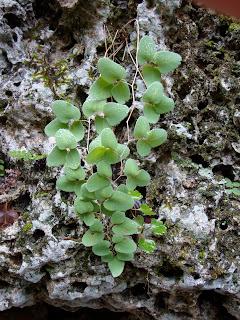Which is a huge expectation to have on the creek, and the trail, and all the plants that grow along it. In that state of mind, distracted and restless and not sure whether I was ready to embrace the late start of spring, the season of acceleration, I went to the Greenbelt expecting to be dazzled by bright, fat Buckeye flowers and vibrant spring ephemerals. Instead I found quiet. The creek was still running, though barely so and only along the upstream half of the Greenbelt, the trees were still leafless, and the browned, crispy, long-dead grasses and herbs of last summer and fall still lined the trail and the creek. Even the once-purple berries of the Beautyberry shrubs had shriveled and turned black. The obvious landscape of greys and browns certainly wasn't about to grab my attention.
But the creek, even when it's barely running, and the experience of being out in the woods, even when the branches are bare, still has the effect of slowing me down, and, despite my impatience, I began to appreciate the damp smell of the woods and the misty, almost-raining morning that was contributing to the quiet. Then I noticed the plants that thrive in the cool humidity and quiet between winter and spring. The mosses seemed especially happy with the misty, damp conditions.
The ferns growing from the rock walls along the creek showed signs of freeze damage, with browned leaves and partially dead fronds. But the ferns or parts of ferns that had survived the freezes of early February were growing as happily as the mosses, enjoying the non-stressful, humid weather.
 |
| Cliff Brake Fern (Pellaea ovata) |
Once I began noticing some green, I realized that, actually, at the ground level, green was overtaking the brown. New blades of grass were emerging from the leaf layer and green rosettes of annual herbs were establishing themselves, gathering strength to become the wildflowers of spring.
In the understory, native winter berries – red Yaupon and blue-black Silktassel – added color to the branches of evergreen shrubs. Berries also hung on the branches of non-native shrubs, escaped from cultivation, including the small, blue-black fruits on Japanese Privet trees (Ligustrum japonicum) and Chinese Privet shrubs (Ligustrum sinese). Nandina shrubs held huge clusters of red-orange fruits. Nandina (Nandina domestica), like Japanese and Chinese privet, is a native of Asia that was brought to the US for use in gardens and has escaped from cultivation. Unfortuantely, Nandina, Japanese Privet, and Chinese Privet are invasive and are spreading into streamside habitats around Austin.
 |
| Nandina (Nandina domestica) berries |
And, though small and subtle, not yet grabbing my attention in numbers but there to be noticed as individual dots of color in the underbrush along the trail, the earliest wildflowers of the season were just starting to bloom. The first wildflower that I spotted this season was Golden Grounsel (Packera obovata), a sunflower-family herb with bright-yellow flowers. Golden Grounsel grows as a rosette of almost-round to oval leaves that become deeply lobed when the plant makes a flowering stalk. Golden Groundsel prefers to grow in moist, calcareous soils and blooms February through April, making it one of the first wildflowers of the spring in central Texas. Its yellow flowers attract bees and butterflies.
 |
| Golden Groundsel (Packera obovata) leaves |
 |
| Golden Groundsel (Packera obovata) flowers |
Roemer's Spurge, an annual herb of moist, shaded woodlands, was also beginning to bloom. Roemer's Spruge (Euphorbia roemeriana) has unique leaves and branching. The lower leaves on a stalk are alternate and elogated, then a whorl of three leaves gives rise to three stems, each holding an inflorescence (cluster of flowers). The bract at the base of the inflorescence is almost circular, made of two fused leaves. The flowers are tiny and bright yellow, appearing on the plants late February through May.
 |
| Roemer's Spruge (Euphorbia roemeriana) |
Missouri Violet, a perennial herb that is a common spring ephemeral in moist, streamside woodlands throughout the central United States, was also blooming. Missouri Violet (Viola missouriensis) is a perennial herb that grows as a rosette of heart-shaped leaves and blooms early in the spring, in February through April in central Texas. Flowers on the wild violets signal that spring, though delayed by the cold weather and slow to get started this year, is on the way.
 |
| Missouri Violet (Viola missouriensis) |



No comments:
Post a Comment